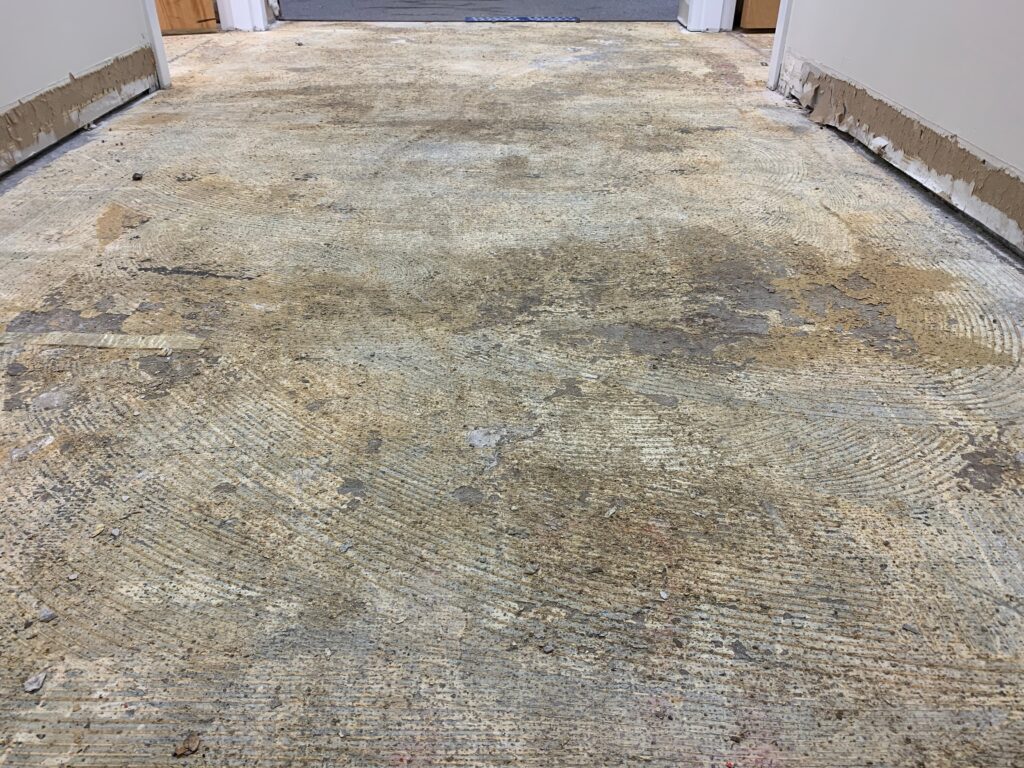
As a building or business owner, deciding which flooring type will depend on factors such as overall design, ease of installation, and cost. Understanding the steps involved when choosing a flooring option like carpet can help you prepare for the job and estimate costs. The crew at Division 9 Commercial Construction broke down the steps in this blog to help business and building owners prepare to install their new flooring.
1.) Pre-Installation Checks
Pre-installation checks are necessary to kick off any flooring project, especially carpet. This involves evaluating the current condition of the subfloor and ensuring it is clean, dry, and, most importantly, level. Any existing flooring or debris should be removed to provide a smooth surface for the new carpet. Additionally, you’ll need to check for any potential moisture issues, as excess moisture can lead to mold growth and damage to the carpet over time.
2.) Floor Preparation
Floor preparation is necessary to help ensure an easier installation. During floor prep and inspection, issues like cracks, uneven surfaces, and other imperfections may arise. These issues must be resolved before any next steps. This can involve filling in gaps, sanding rough areas, and ensuring the subfloor is completely dry. In some cases, a primer may be applied to enhance adhesion and provide a more stable base for the carpet.

3.) Carpet Underlay Installation
Installing an underlay is an important and necessary step that provides additional cushioning and prolongs the life of your carpet. The underlay helps to absorb impact, reduce noise, and improve overall comfort. It’s important to choose the right type of underlay for your specific needs, whether for heavy foot traffic areas or added insulation. The underlay should be cut to fit the space precisely and secured in place to prevent any shifting or wrinkling of the carpet.
4.) Carpet Layout
Next, the installers will roll out and lay the carpet in the designated area. During this time, the carpet seams are positioned in low-traffic areas and the carpet grain runs in the same direction throughout the space. Proper measurements and cuts avoid wastage and ensure a perfect fit. If your commercial space is large, you may need to sew multiple pieces of carpet together, which should be done precisely to create an invisible join.
5.) Gluing the Carpet to the Cushion
For many commercial installations, the carpet is glued directly to the cushion or underlay. This process provides a secure and stable installation that can withstand heavy use. A high-quality adhesive should be used to ensure strong bonding. The carpet is then positioned and pressed into the adhesive, starting from the center and working outwards to avoid any air bubbles or wrinkles. Rolling the carpet with a heavy-duty roller helps to ensure proper adhesion and a smooth finish.
6.) Trimming and Securing Edges
Once the carpet is glued down, the edges must be trimmed and secured. This involves cutting the excess carpet along the walls and other fixed structures, ensuring a clean and precise edge. Special attention should be given to corners and doorways to ensure a seamless transition between different flooring surfaces. In some cases, metal or rubber edging strips may be installed to provide additional protection and a polished look.
7.) Final Inspection and Clean-Up
After the carpet installation is complete, a final inspection is necessary to ensure the carpet is properly secured and free of defects. This includes checking for any loose areas, wrinkles, or seams needing additional attention. Once everything is in place, the space should be thoroughly cleaned to remove installation debris, adhesive residue, and dust.
When choosing carpeting for your commercial building, understanding how the installation process works can help you prepare for your new flooring. The proper pre-installation checks, floor preparation, and careful attention to detail throughout each step will result in a carpet installation that is durable, comfortable, and visually appealing. If you’re considering new carpets for your commercial property, contact Division 9 Commercial Construction to learn more about our expert installation services.
